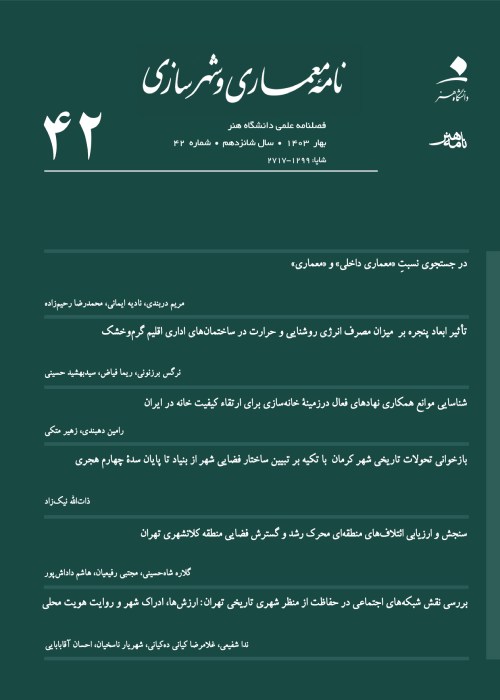Neighborhood Design Using Parametric Design Method Based on Patterns of Traditional Urban Textures in Kashan City
Author(s):
Abstract:
Complexity and uncertainly of cities raises some doubts about definitive and solid decisions in the field of urban design. The context of a project، as a starting point of urban design، is changing constantly in non-linear way. Moreover، various stakeholders are involved in design and realization of an urban plan. Cities are dynamic systems. Their configuration، spatial and social characteristics are the result of a large number of factors that are in some way involved in، or influence، the way a settlement is built، as well as its dynamics. Contrary to the critical tendency directed towards planning methods، the majority of the existing tools are still destined for the design of urban plans in the traditional layout. In all cases the aim is to produce a fixed layout for top-down implementation in a particular area. Traditional urban plans have definitive design systems، without the flexibility required to deal with the complexity and change that characterize contemporary urban societies. To provide urban plans with increased flexibility، a design methodology is proposed capable of producing various design solutions instead of a specific definitive design. Therefore the objective of urban design needs to move from static design of a specific layout towards complex and dynamic design of generic solutions. The structure of environmental information has the potential to be transformed into design parameters. Parametric urban design method would make it possible to change environmental information in each step of design process and the result would change in accordance with new inputs. This characteristic of parametric design method will make it possible for designers to know their design consequence each time they make a new design decision. The aim of this research is to investigate the potential and benefits of parametric urban design method. Then a neighborhood is designed using parametric design method. The structure of the paper consists of two parts: the theoretical studies and the design process. The design area is a part of neighborhood in Iran، Kashan city. Considering the organic urban texture of Kashan city and the fragmentation between new and old urban textures caused by modern thoughts، the creation of design consistent with context is of importance. It would help to create new context as a connector and simultaneously coordinator of old and new urban textures. So in this study، the main elements of design have been developed based on lynch and Alexander theories، then by defining parameters in the Rhino Grasshopper software، a flexible scheme for the neighborhood has been designed. The defined design system is dynamic and will update with each input change. The design is based on information and complex interrelation and creation of final scheme is in accordance with existing urban texture، so the process would be recursive and planners and public participation in the urban design process would be possible. The approach shown here is responsible for creating an environment which enhances awareness of the impacts of design decisions throughout a progressively evolving urban design process.
Keywords:
Language:
Persian
Published:
Journal of Architecture and Urban Planning, Volume:8 Issue: 15, 2015
Pages:
97 to 112
https://magiran.com/p1444481
دانلود و مطالعه متن این مقاله با یکی از روشهای زیر امکان پذیر است:
اشتراک شخصی
با عضویت و پرداخت آنلاین حق اشتراک یکساله به مبلغ 1,390,000ريال میتوانید 70 عنوان مطلب دانلود کنید!
اشتراک سازمانی
به کتابخانه دانشگاه یا محل کار خود پیشنهاد کنید تا اشتراک سازمانی این پایگاه را برای دسترسی نامحدود همه کاربران به متن مطالب تهیه نمایند!
توجه!
- حق عضویت دریافتی صرف حمایت از نشریات عضو و نگهداری، تکمیل و توسعه مگیران میشود.
- پرداخت حق اشتراک و دانلود مقالات اجازه بازنشر آن در سایر رسانههای چاپی و دیجیتال را به کاربر نمیدهد.
In order to view content subscription is required
Personal subscription
Subscribe magiran.com for 70 € euros via PayPal and download 70 articles during a year.
Organization subscription
Please contact us to subscribe your university or library for unlimited access!


